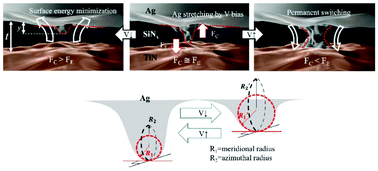Analytically and empirically consistent characterization of the resistive switching mechanism in a Ag conducting-bridge random-access memory device through a pseudo-liquid interpretation approach
Abstract
A new physical analysis of the filament formation in a Ag conducting-bridge random-access memory (CBRAM) device in consideration of the existence of inter-atomic attractions caused by metal bonding is suggested. The movement of Ag atoms inside the switching layer is characterized hydrodynamically using the Young–Laplace equation during set and reset operations. Both meridional and azimuthal curvatures of the Ag filament protruding from the Ag electrode are accurately calculated to track down the exact shape of the Ag filament with change in the applied voltage. The second-order partial differential equation for the Ag filament geometry is derived from the equation of equilibrium between the electrostatic pressure and the Laplace one. The solution to the equation is numerically obtained, and furthermore, the abrupt set operation in the forming process, bipolar resistive-switching, and the threshold switching operation in the reset operations are successfully simulated in accordance with the numerical solutions. Also, it is demonstrated that the currents extracted from the suggested model show good agreement with the I–V characteristics measured from the fabricated Ag CBRAM device.

- This article is part of the themed collection: 2021 PCCP HOT Articles


 Please wait while we load your content...
Please wait while we load your content...